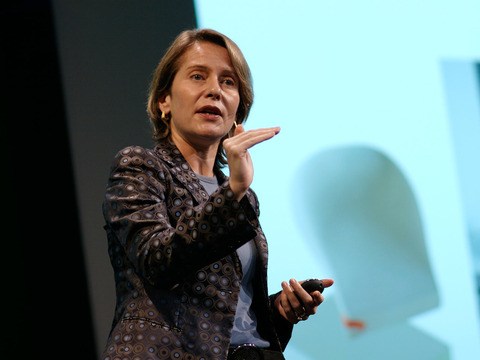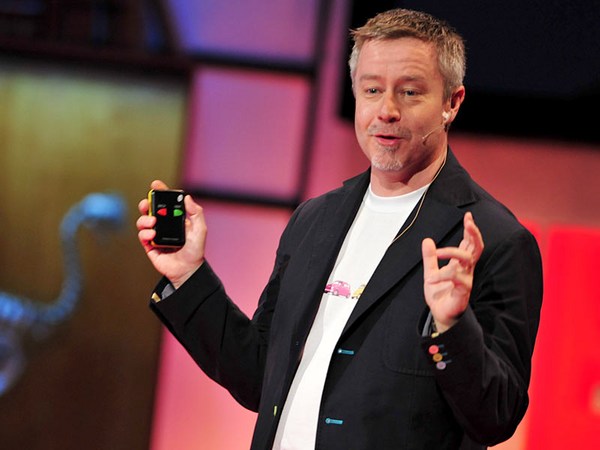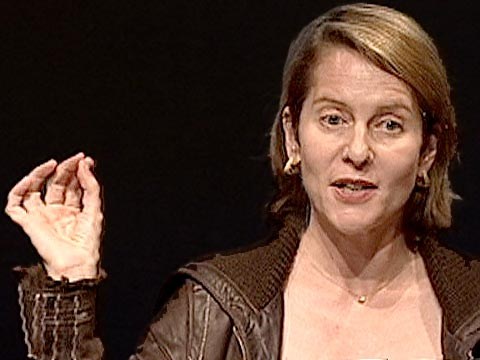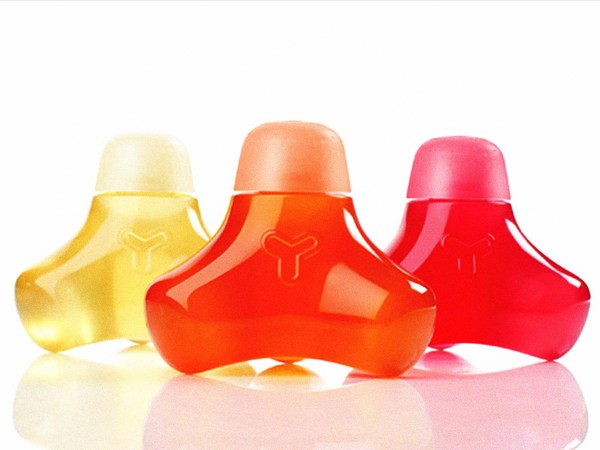I was listed on the online biography that said I was a design missionary. That's a bit lofty; I'm really more of something like a street walker. I spend a lot of time in urban areas looking for design, and studying design in the public sector. I take about 5,000 photographs a year, and I thought that I would edit from these, and try to come up with some images that might be appropriate and interesting to you. And I used three criteria: the first was, I thought I'd talk about real design within reach, design that's free, not design not quite within reach, as we're fondly known by our competition and competitors, but stuff that you can find on the streets, stuff that was free, stuff that was available to all people, and stuff that probably contains some other important messages.
I'll use these sidewalks in Rio as an example. A very common public design done in the '50s. It's got a nice kind of flowing, organic form, very consistent with the Brazilian culture -- I think good design adds to culture. Wholly inconsistent with San Francisco or New York. But I think these are my sort of information highways: I live in much more of an analog world, where pedestrian traffic and interaction and diversity exchange, and where I think the simple things under our feet have a great amount of meaning to us.
How did I get started in this business? I was a ceramic designer for about 10 years, and just loved utilitarian form -- simple things that we use every day, little compositions of color and surface on form. This led me to starting a company called Design Within Reach, a company dealing with simple forms, making good designers available to us, and also selling the personalities and character of the designers as well, and it seems to have worked. A couple of years into the process, I spent a lot of time in Europe traveling around, looking for design.
And I had a bit of a wake-up call in Amsterdam: I was there going into the design stores, and mixing with our crowd of designers, and I recognized that a whole lot of stuff pretty much looked the same, and the effect of globalization has had that in our community also. We know a lot about what's going on with design around the world, and it's getting increasingly more difficult to find design that reflects a unique culture. I was walking around on the streets of Amsterdam and I recognized, you know, the big story from Amsterdam isn't what's in the design stores, it's what's out on the streets, and maybe it's self-explanatory, but a city that hasn't been taken over by modernism, that's preserved its kind of architecture and character, and where the bicycle plays an important part of the way in which people get around and where pedestrian rights are protected. And I write a newsletter that goes out every week, and I wrote an article about this, and it got such enormous response that I realized that design, that common design, that's in the public area means a lot to people, and establishes kind of a groundwork and a dialog.
I then kind of thought about the other cities in Europe where I spend a lot of time looking for design, like Basel, where Vitra is located, or in northern Italy -- all cities where there are a whole lot of bicycles, and where pedestrian areas -- and I came to the conclusion that perhaps there was something about these important design centers that dealt with bicycles and foot traffic, and I'm sure the skeptic eye would say, no, the correlation there is that there are universities and schools where people can't afford cars, but it did seem that in many of these areas pedestrian traffic was protected. You wouldn't look at this and call this a designer bike: a designer bike is made of titanium or molybdenum. But I began looking at design in a place like Amsterdam and recognized, you know, the first job of design is to serve a social purpose. And so I look at this bike as not being a designer bike, but being a very good example of design.
And since that time in Amsterdam, I spent an increasing amount of time in the cities, looking at design for common evidence of design that really isn't under so much of a designer's signature. I was in Buenos Aires very recently, and I went to see this bridge by Santiago Calatrava. He's a Spanish architect and designer. And the tourist brochures pointed me in the direction of this bridge -- I love bridges, metaphorically and symbolically and structurally -- and it was a bit of a disappointment, because of the sludge from the river was encrusted on it; it really wasn't in use. And I recognized that oftentimes design, when you're set up to see design, it can be a bit of a letdown.
But there were lots of other things going on in this area: it was a kind of construction zone; a lot of buildings were going up. And, approaching a building from a distance, you don't see too much; you get a little closer, and you arrive at a nice little composition that might remind you of a Mondrian or a Diebenkorn or something. But to me it was an example of industrial materials with a little bit of colors and animation and a nice little still life -- kind of unintended piece of design. And going a little closer, you get a different perspective. I find these little vignettes, these little accidental pieces of design, to be refreshing. They give me, I don't know, a sense of correctness in the world and some visual delight in the knowledge that the building will probably never look as good as this simple industrial scaffolding that is there to serve.
Down the road, there was another building, a nice visual structure: horizontal, vertical elements, little decorative lines going across, these magenta squiggles, the workmen being reduced to decorative elements, just a nice, kind of, breakup of the urban place. And, you know, that no longer exists. You've captured it for a moment, and finding this little still life's like listening to little songs or something: it gives me an enormous amount of pleasure. Antoine Predock designed a wonderful ball stadium in San Diego called Petco Park. A terrific use of local materials, but inside you could find some interior compositions. Some people go to baseball stadiums to look at games; I go and see design relationships. Just a wonderful kind of breakup of architecture, and the way that the trees form vertical elements.
Red is a color in the landscape that is often on stop signs. It takes your attention; it has a great amount of emotion; it stares back at you the way that a figure might. Just a piece of barrier tape construction stuff in Italy. Construction site in New York: red having this kind of emotional power that's almost an equivalent with the way in which -- cuteness of puppies and such. Side street in Italy. Red drew me into this little composition, optimistic to me in the sense that maybe the public service's mailbox, door service, plumbing. It looks as if these different public services work together to create some nice little compositions. In Italy, you know, almost everything, kind of, looks good. Simple menus put on a board, achieving, kind of, the sort of balance. But I'm convinced that it's because you're walking around the streets and seeing things. Red can be comical: it can draw your attention to the poor little personality of the little fire hydrant suffering from bad civic planning in Havana. Color can animate simple blocks, simple materials: walking in New York, I'll stop.
I don't always know why I take photographs of things. A nice visual composition of symmetry. Curves against sharp things. It's a comment on the way in which we deal with public seating in the city of New York. I've come across some other just, kind of, curious relationships of bollards on the street that have different interpretations, but -- these things amuse me. Sometimes a trash can -- this is just in the street in San Francisco -- a trash can that's been left there for 18 months creates a nice 45-degree angle against these other relationships, and turns a common parking spot into a nice little piece of sculpture. So, there's this sort of silent hand of design at work that I see in places that I go.
Havana is a wonderful area. It's quite free of commercial clutter: you don't see our logos and brands and names, and therefore you're alert to things physically. And this is a great protection of a pedestrian zone, and the repurposing of some colonial cannons to do that. And Cuba needs to be far more resourceful, because of the blockades and things, but a really wonderful playground.
I've often wondered why Italy is really a leader in modern design. In our area, in furnishings, they're sort of way at the top. The Dutch are good also, but the Italians are good. And I came across this little street in Venice, where the communist headquarters were sharing a wall with this Catholic shrine. And I realized that, you know, Italy is a place where they can accept these different ideologies and deal with diversity and not have the problem, or they can choose to ignore them, but these -- you don't have warring factions, and I think that maybe the tolerance of the absurdity which has made Italy so innovative and so tolerant. The past and the present work quite well together in Italy also, and I think that it's recognizable there, and has an important effect on culture, because their public spaces are protected, their sidewalks are protected, and you're actually able to confront these things physically, and I think this helps people get over their fear of modernism and other such things.
A change might be a typical street corner in San Francisco. And I use this -- this is, sort of, what I consider to be urban spam. I notice this stuff because I walk a lot, but here, private industry is really kind of making a mess of the public sector. And as I look at it, I sort of say, you know, the publications that report on problems in the urban area also contribute to it, and it's just my call to say to all of us, public policy won't change this at all; private industry has to work to take things like this seriously.
The extreme might be in Italy where, again, there's kind of some type of control over what's happening in the environment is very evident, even in the way that they sell and distribute periodicals. I walk to work every day or ride my scooter, and I come down and park in this little spot. And I came down one day, and all the bikes were red. Now, this is not going to impress you guys who Photoshop, and can do stuff, but this was an actual moment when I got off my bike, and I looked and I thought, it's as if all of my biker brethren had kind of gotten together and conspired to make a little statement. And it reminded me that -- to keep in the present, to look out for these kinds of things.
It gave me possibilities for wonder -- if maybe it's a yellow day in San Francisco, and we could all agree, and create some installations. But it also reminded me of the power of pattern and repetition to make an effect in our mind. And I don't know if there's a stronger kind of effect than pattern and the way it unites kind of disparate elements. I was at the art show in Miami in December, and spent a couple of hours looking at fine art, and amazed at the prices of art and how expensive it is, but having a great time looking at it. And I came outside, and the valets for this car service had created, you know, quite a nice little collage of these car keys, and my closest equivalent were a group of prayer tags that I had seen in Tokyo. And I thought that if pattern can unite these disparate elements, it can do just about anything.
I don't have very many shots of people, because they kind of get in the way of studying pure form. I was in a small restaurant in Spain, having lunch -- one of those nice days where you had the place kind of to yourself, and you have a glass of wine, and enjoying the local area and the culture and the food and the quiet, and feeling very lucky, and a bus load of tourists arrived, emptied out, filled up the restaurant. In a very short period of time, completely changed the atmosphere and character with loud voices and large bodies and such, and we had to get up and leave; it was just that uncomfortable. And at that moment, the sun came out, and through this perforated screen, a pattern was cast over these bodies and they kind of faded into the rear, and we left the restaurant kind of feeling O.K. about stuff.
And I do think pattern has the capability of eradicating some of the most evil forces of society, such as bad form in restaurants, but quite seriously, it was a statement to me that one thing that you do, sort of, see is the aggressive nature of the industrial world has produced -- kind of, large masses of things, and when you -- in monoculture, and I think the preservation of diversity in culture is something that's important to us.
The last shots that I have deal with -- coming back to this theme of sidewalks, and I wanted to say something here about -- I'm, kind of, optimistic, you know. Post-Second World War, the influence of the automobile has really been devastating in a lot of our cities. A lot of urban areas have been converted into parking lots in a sort of indiscriminate use. A lot of the planning departments became subordinated to the transportation department. It's as easy to rag on cars as it is on Wal-Mart; I'm not going to do that. But they're real examples in urbanization and the change that's occurred in the last number of years, and the heightened sensitivity to the importance of our urban environments as cultural centers. I think that they are, that the statements that we make in this public sector are our contributions to a larger whole.
Cities are the place where we're most likely to encounter diversity and to mix with other people. We go there for stimulation in art and all those other things. But I think people have recognized the sanctity of our urban areas. A place like Chicago has really reached kind of a level of international stature. The U.S. is actually becoming a bit of a leader in kind of enlightened urban planning and renewal, and I want to single out a place like Chicago, where I look at some guy like Mayor Daley as a bit of a design hero for being able to work through the political processes and all that to improve an area. You would expect a city like this to have upgraded flower boxes on Michigan Avenue where wealthy people shop, but if you actually go along the street you find the flower boxes change from street to street: there's actual diversity in the plants. And the idea that a city group can maintain different types of foliage is really quite exceptional.
There are common elements of this that you'll see throughout Chicago, and then there are your big-D design statements: the Pritzker Pavilion done by Frank Gehry. My measure of this as being an important bit of design is not so much the way that it looks, but the fact that it performs a very important social function. There are a lot of free concerts, for example, that go on in this area; it has a phenomenal acoustic system. But the commitment that the city has made to the public area is significant, and almost an international model. I work on the mayor's council in San Francisco, on the International Design Council for Mayors, and Chicago is looked at as the pinnacle, and I really would like to salute Mayor Daley and the folks there. I thought that I should include at least one shot of technology for you guys. This is also in Millennium Park in Chicago, where the Spanish artist-designer Plensa has created, kind of, a digital readout in this park that reflects back the characters and personalities of the people in this area. And it's a welcoming area, I think, inclusive of diversity, reflective of diversity, and I think this marriage of both technology and art in the public sector is an area where the U.S. can really take a leadership role, and Chicago is one example.
Thank you very much.





